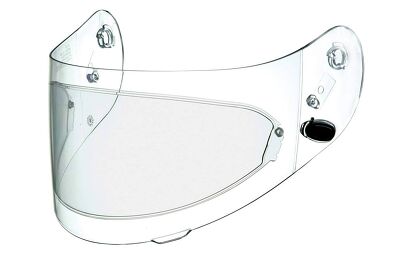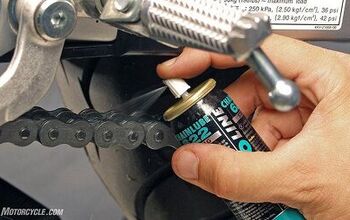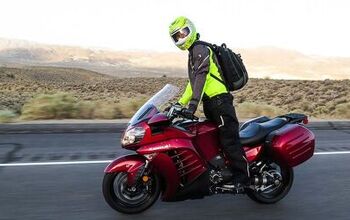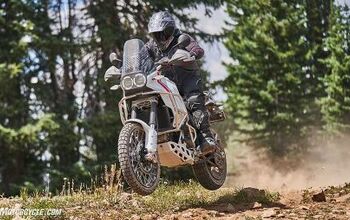Best Cold Weather Motorcycle Gear

The right winter motorcycle gear can make all the difference
Winter can be a tough time of year for motorcyclists – particularly those who live in northern states. While nothing outside of screwing studs into your bike’s tires and going ice racing can help you scratch the two-wheeled itch once the white stuff hits the ground, there are still plenty of opportunities for riding if you are prepared with the right cold weather motorcycle gear.
Winter riding newbies typically ask us some pretty similar questions: Does leather keep you warm on a motorcycle? Does wearing rain gear over my regular gear help keep me warmer? Do I have to wear expensive motorcycle-specific winter gear? All of these questions can be summed up into “What should I wear while riding a motorcycle in the winter?”
First, everyone’s definition of winter riding is different. In sunny SoCal, the thermometer dipping below 50° F is a sign of the coming apocalypse. In New England, temperatures in the single digits might not even register with some seasoned riders. It all comes down to what level of discomfort you’re willing to endure and how much insulation you’re able to pack around your body. Supplemental heat is also an important consideration for lengthening your riding season.
In winter, just like any other time you’re on your motorcycle, you want to wear gear that protects you in case of a crash. That means CE-certified armor on your back, elbows, knees, and shoulders. Naturally, quality motorcycle-specific riding apparel will include this kind of protection. Leather riding gear can help keep winter’s cold wind from directly reaching your body, but it isn’t great for insulating against the cold. You can augment your leather with thermal base layers or electric underclothing. Insulated over suits are another option to augment your leather. Still, nothing beats gear that was designed for winter from the get-go.
We’ve compiled a list of what we think are the five best pieces of gear to help you extend your personal riding season. Of course, there are tons of other items the winter rider could consider, but we thought that with these items, you would be well on your way towards keeping yourself riding when the temperature and the leaves have dropped.
Table of Contents
Spidi 4Season H2Out Suit
Spidi believes that a multi-functional suit is built with layers, and it is the three-layered construction that gives the Spidi 4Season Out jacket and pants their name. The all-important abrasion protection comes from the exterior of the suit, which is constructed of what Spidi calls tenax Nylon 6.6. For warm weather riding, a variety of wind/waterproof zippered vents allow for cooling airflow. Then there’s the waterproofness of the second layer, which is completely removable for dry days.
Finally, one of the nicest features of the 4Season is the fiber-filled quilted liner. This lightweight insulated jacket is worn under the other two layers, keeping the rider’s core and arms warm when the temperature drops. The quilted liner also looks good enough to wear when warmth is desired off of the bike. While the 4Season pants lack the insulating layer, they provided enough weather protection with their two layers to keep me warm on a Gold Wind Tour in the low 20° F range. A good base layer helps with the legs, though. All this versatility comes at a price, though, and the Spidi 4Season Jacket and Pants aren’t cheap, but they’re worth it. You can find the jacket here and the pants here.
Bottom Line
- A versatile multi-season jacket and pants combination
Aerostich Kanetsu Airvantage Electric Vest
Want to keep your core warm when the temperature really drops? Then provide it with an external source of heat. The Kanetsu Airvantage Electric Vest is constructed with a windproof outer layer to fend off cold drafts. The inner layer of the vest consists of the nylon liner that holds a wired heating element. Sandwiched in between those layers is a clever air bladder to provide insulation.
However, the secret sauce of this setup is that the air pressure within the bladder allows the rider to press the heating elements right up against their torso to more efficiently transfer the heat. A side benefit of the bladder is that it helps to apply an even pressure across the heated wires, eliminating hot spots. For those with jackets that don’t seal as well as they should, the Kanetsu Airvantage has optional sleeves ($97) to help block the breeze. Order your $247 Aerostich Kanetsu Airvantage Electric Vest direct from Aerostich. Those who live in truly bitter climates may want to go for the full-monty Aerostich Kanetsu AIRVANTAGE Electric Liner ($377).
MO Tested: Aerostich Kanetsu Airvantage Electric Vest Review
Bottom Line
- Adjust the fit and heat delivery via the amount of air in the internal bladder
Rev It! Sky Base Layers
Those of us of a certain age will remember the waffle-shaped cotton fabric of the thermal underwear of our youth. Under ideal situations, they worked just fine, but with a little perspiration or other moisture, things could get cold quickly. Modern base layers understand their dual purposes of providing insulation while simultaneously wicking moisture away from the skin. Rev It’s Sky base layer clothing addresses this issue through its use of “push-pull” fabric that immediately moves moisture away from the skin to the fabric surface where it can either evaporate or be wicked away by the next layer of clothing. Rev It Sky shirts ($65) and pants ($50) are available in both men’s and women’s sizes.
Bottom Line
- Base layers serve a dual purpose of retaining heat while wicking moister away
Pinlock EVO Visor
While the Pinlock EVO visor has nothing to do with warmth, being able to see is essential to safe riding. When it’s cold outside, your warm, moist breath is most prone to fogging up your visor. Pinlock EVO visors are so effective at preventing fog that many premium helmet manufacturers are shipping them with new helmets. (Other manufacturers also make Pinlock-ready shields that you can buy.) A combination of an air-tight double shield insulating the visor interior surface from the cold outside and the plastic’s water absorption properties keep the shield fog-free – even during a commute in winter rain. These easy-to-install and clean visor liners pass the ECE-standards mist-retardant test by a factor 6. They are available in colors ranging from clear to yellow to dark tint and range in price from $30-$60.
Bottom Line
- You can't see where you're going if your visor is fogged
Oxford Heaterz Grips
Here’s another item that you don’t wear but is essential for cold-weather riding. Unless you’re wearing heated gloves, it’s almost impossible to keep your mitts toasty – even with heavily insulated winter gloves. This is where heated grips shine. Oxford Heaterz line of grips is built for different classes of motorcycles, from cruiser to touring to adventure to whatever you ride. The grips are constructed of rubber with all-silicone wiring to prevent cracking in the cold. The key to the system is, however, the variable settings (five of them!) to tune the heat that your environment needs. Additionally, the switch will power down if the battery’s voltage drops below 10.5 volts (though we recommend wiring it to switched power to prevent the possibility of killing your battery by failing to turn off the grips). Oxford Heaterz Grips range in price from $70-$100, depending on the application.
Bottom Line
- Warm hands operate motorcycle controls much easier
We are committed to finding, researching, and recommending the best products. We earn commissions from purchases you make using the retail links in our product reviews and other articles. Learn more about how this works.
Become a Motorcycle.com insider. Get the latest motorcycle news first by subscribing to our newsletter here.

Like most of the best happenings in his life, Evans stumbled into his motojournalism career. While on his way to a planned life in academia, he applied for a job at a motorcycle magazine, thinking he’d get the opportunity to write some freelance articles. Instead, he was offered a full-time job in which he discovered he could actually get paid to ride other people’s motorcycles – and he’s never looked back. Over the 25 years he’s been in the motorcycle industry, Evans has written two books, 101 Sportbike Performance Projects and How to Modify Your Metric Cruiser, and has ridden just about every production motorcycle manufactured. Evans has a deep love of motorcycles and believes they are a force for good in the world.
More by Evans Brasfield

































Comments
Join the conversation
A balaclava that covers the face and seals off the neck area from any wind intrusion is a big help. Heated gear is THE key to staying warm, been using at least a vest for 35 years now.
After 30 years of loyal service, my ancient Eclipse heated vest finally died. Testing with my multimeter showed it's controller still works, the heating element inside the vest itself must have broken. Timely article - after all those years I guess it is time to pick up a new electric vest, they are a must have item for cold weather.
Between the heated vest and Oxford Heated grips, high quality gloves and good thermal layering, I can ride in pretty much any weather that does not feature snow on the road. It helps that my bike (a Super Tenere) is a big ADV whale with lots of wind protection. There are times when my toes get a bit cold but the rest of me is fine, as I am basically dressed for a snowmobile outing. Concur on the baclava comment, keeping cold drafts out of the helmet is a key piece of cold weather gear.
I actually like riding in the semi cold, because it can be dressed for and dealt with. A lot of bike's seats get warm in hot weather, which causes heat induced roasted nuts / monkey butt syndrome, which is not an issue in the cold. I find I can comfortably sit longer in cold weather, when it is truly blazing hot, there is no way to not suffer on a motorcycle.